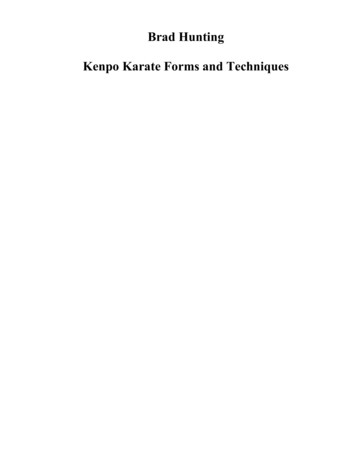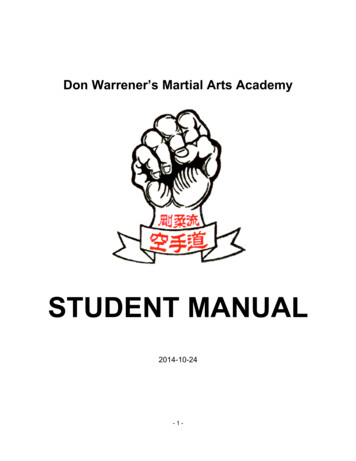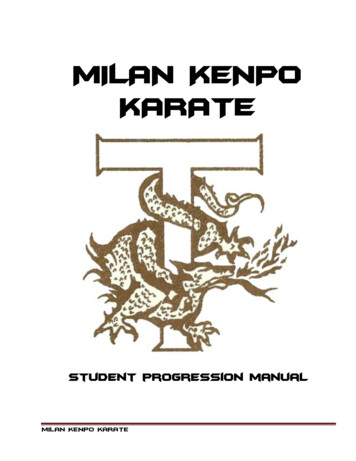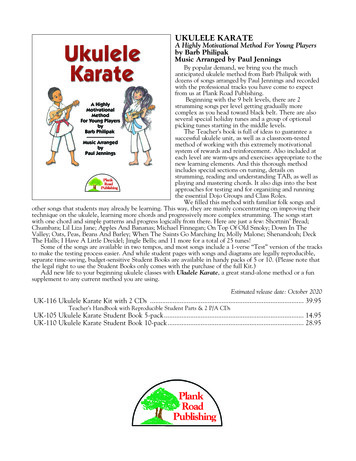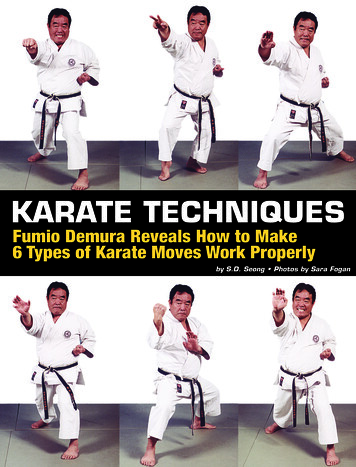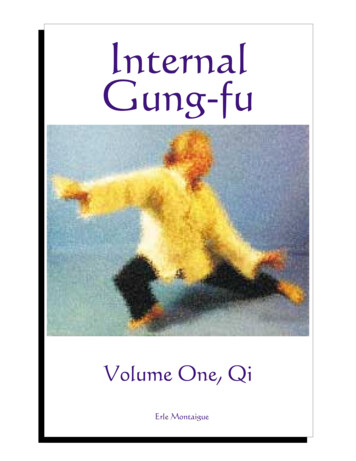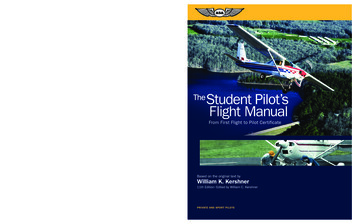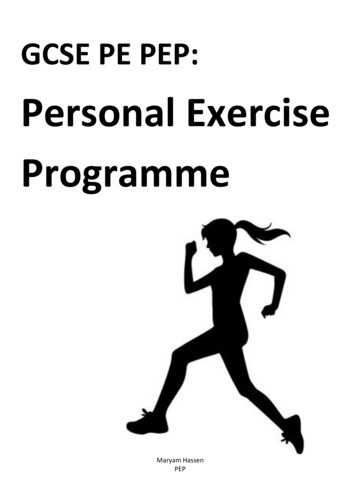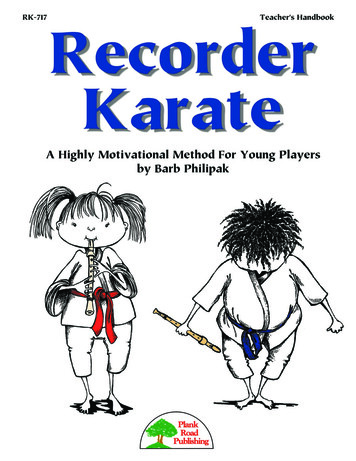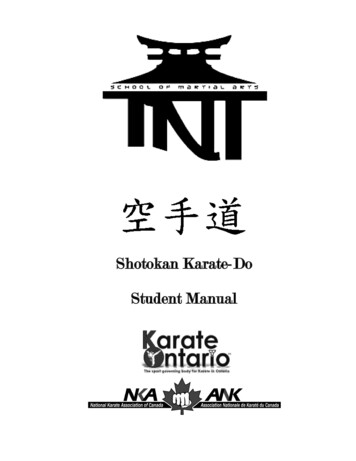
Transcription
Shotokan Karate-DoStudent Manual
TNT School of Martial Arts Shotokan Karate-Do1Table of ContentsKarate History3Martial Arts Biography of Joshua Carrick2The Founder of the National Karate Association4Karate Philosophy5Dojo Etiquette and Attitude6At the Dojo: Procedures and Protocol7Shotokan Code of Ethics8Dojo Kun9What is a Sensei?10What is Deep Breathing?11The Kiai12Practice Intelligently13Positive Self-talk14Kata Training15TNT School of Martial Arts Shotokan Kata Cirriculum16The Origins of Shotokan Kata17Karate as Self-Defense19Karate as a Sport20Master Gichin Funakoshi’s 20 precepts of Karate-Do21Student Summary Sheet22Important Points to Remember23Karate Terminologies24Karate Kyu Exam Evaluation25Kyu Grading Requirements26Appendix: Kyu Academic Self-tests30Self-test 1: Yellow Belt exam (8th kyu)Self-test 2: Orange Belt exam (7th kyu)Self-test 3: Green Belt exam (6th kyu)Self-test 4: Blue Belt exam (5th kyu)Self-test 5: Purple Belt exam (4th kyu)Self-test 6: Brown Belt exam (3rd kyu)Self-test 7: Brown Belt exam (2nd kyu)Self-test 8: Brown Belt exam (1st kyu)
2Martial Arts Biography ofJoshua CarrickMr. Joshua Carrick was born 1975 inLindsey Ontario, Canada, but did most of hisgrowing up in the New Tecumseth area andbegan his Traditional Karate-Do training in 1983at the Bolton Japan Karate Association. Hestudied with 5th degree Sensei I. Fung, and with8th degree Master T.Okuyama of ISK, whogranted him a 1st degree Shodan in 1993. In1994, Mr. Carrick decided to pursue other formsof martial arts. He trained with Sifu Don Munce,a student of Martin and Michael Macnammarafor 7 years in a style of Kung Fu and Kickboxing.After competing in full contact amateurkickboxing 1994 to 1999 and achieving 1 bronze,2 silver, and 1 gold in the Eastern CanadianChampionships Montreal, Quebec, and in 1999Joshua Carrick represented Ontario at theNationals in Calgary, Alberta; at the W.K.A.(World Kickboxing Association) NationalKickboxing Championships and receiving thetitle of Golden Gloves Full Contact Fighter, forthe cruiser-weight division.Mr. Joshua Carrick returned to ShotokanKarate training in 2002 under chief instructor 6thdegree Shihan Brad Jones. Mr. Carrick has beenactively involved in coaching and instruction atthe Brad Jones School of Karate, achieving his 2nddegree Nidan in 2004, and 3rd degree Sandan in2007.Mr. Joshua Carrick has been a member ofKarate Ontario for several years, andrepresented Ontario at the Nationals in 2005Halifax, Nova Scotia. He’s been competing atboth Karate Ontario tournaments, and opentournaments since the 1990’s. Mr. Carrick‘straveled to Japan and Okinawa to further histraining; While in Tokyo, 2005, Joshua Carrickcompleted a three day instructors trainingseminar at the J.K.A. (Japan Karate Association)head quarters.Mr. Carrick has maintained Red CrossFirst Aid Certification, and completed Level 1Karate coach (N.C.C.P.) National CoachingCertification Program.
Karate HistoryThe word “Karate” has been known since the1920’s; however the roots of the art extend back wellover a thousand years and possibly to the 5th century B.C.According to legend, a Buddhist monk named BodhiDharma took unarmed combat techniques, practiced inIndia, with him to China. There he developed a system ofphysical training based on yoga breathing methods and aChinese unarmed fighting method called “Kempo.”China’s advanced knowledge of acupuncture improvedthe kempo techniques by making use of weak points inthe human body. In 628 A.D. a 12 chapter bookappeared which was a curriculum for physical fitness(massage therapy) but did not discuss fightingtechniques. The author of this book claimed to be astudent of Dharma. This is the legend of the beginningsof Karate but can not be taken as factual history. In truthlittle is know about the early development of Karate untilthe 17th century in Okinawa.It was on the Island of Okinawa, the traditionalpoint of contact between the Chinese and the Japanesecultures, where combat techniques developed and selfdevelopment aspects were introduced. Over a longperiod of time a combative art, known as Tang Hand orTang Te, developed from a blend of kempo and Te (hand)which was a form of fighting used by the local people.During the Japanese occupation of Okinawa(1609-1868), the use of weapons was prohibited, whichforced the people to fight with their bare hands. SomeKarate techniques are difficult to explain today since theywere originally used against weapons. Over a period ofsome 300 years different forms of Tang Te evolved invarious areas of the island. In 1902 the Okinawangovernment introduced Karate into the secondary schoolsystem. Itosu was the first instructor; Gichin Funakoshiwas also an instructor of this program. It was at this timethat a systematized and methodological approach tolearning this combative art developed which laterbecame popular among the public.Gichin Funakoshi was born in 1868 and firststudied his Karate techniques which Shuri-te and Shorinmasters Anko Itosu and Yasutsune Azato. Funakoshipracticed calligraphy and published his work under hispen name “Shoto.” The school where he taught Karatebecame known as the Shotokan (Shoto’s school). Laterhis students and many outsiders acknowledge his style ofteaching as Shotokan Ryu; Funakoshi did not refer to hismethodology as such.In 1917, Funakoshi was invited to givedemonstrations in Japan and the Japanese were soimpressed that, in the early 1920’s, Karate was3introduced into the Japanese elementary school systemand given its currently accepted name Karate. As Karatebecame more popular, many other Okinawan expertscame to give instruction in other systems which,although different from each other, were based on thesame common principles. For a short time, at the end ofWorld War II, the teaching of martial arts was outlawedby the American forces, but the ban was soon lifted.Many western service men in Japan during andafter the war studied Karate and spread it to Europe andthe America’s. An increasing number of Japaneseinstructors also moved overseas. During the late 1950’sand the 1960’s this process accelerated and by the 70’sKarate was practiced extensively throughout the world.Unfortunately, this accelerated process resulted in manyinstructors without the knowledge required to fullyunderstand the martial arts of Karate-Do. Theseinstructors created many splinter groups and “homemade” systems (styles).The Japanese Master Funakoshi Gichin who introducedKarate-Do to Japan in 1921, said that “the essence ofKarate-Do is the art of being non-violent”
4The Founder of the National Karate Associationeligible for funding from sport Canada. The N.K.A.promotes and develops traditional Karate throughoutIn order to bring some unity to Karate, theFederation of All Japan Karate-Do Organizations (FAJKO) Canada and Canadian Karate competitors are currentlyrecognized at the international level.was formed in Japan in 1964 and most of the majorThe N.K.A. sponsors a national championshipschools became affiliated with it. A similar process hasgradually taken place in the western countries. A multi- annually, which is part of a four tournament grand prixevaluation system, and by this means its team is selectedstyle World Karate Championships was organized into represent Canada at international events.Tokyo in 1970.Karate Ontario, is the sports governing body inThe most visible differences between theOntario for the practice and sport of Karate, representstraditional styles of Karate and other forms of Karate isthat the training objective of traditional styles, including the province as a branch of the N.K.A. Karate Ontario isits competition rules, specifically require each technique managed by an elected Board of Directors together withvolunteer administrators and utilizes the Ontario Sportsto have sufficient maximum force (kime) to meet theCenter’s Non-Resident Sport Office for administrativeobjective of the technique up to and including theand contact purposes.“finishing blow.” As well, the technical aspects of theMembership with Karate Ontario is throughphysical techniques require the development of forceaffiliatedclubs. All club instructors are verified by Karatefrom a strong and stable base (stance). Other kickingOntariotobe suitably qualified. Each club registers all ofand punching sports do not have competition rules oritsindividualmembers with the organization. Thetraining methodologies that demand such exactingconstitutionofKarate Ontario clearly identifies the rightsrequirements of their techniques. With this distinction,of all its members and participants, its manner ofthe training methods and biomechanics of traditionalconducting the affairs of the association, and the duties ofKarate are much different from other versions of thethe elected Board of Directors and volunteersport.In addition, traditional systems of Karate require administrators.that a strong emphasis be placed on the development ofthe human qualities of the individual students.Traditional Karate was introduced to Canada byMasami Tsuruoka. Often referred to as the father ofCanadian Karate, the Canadian born Tsuruoka studied inthe 1940’s under Dr. Chitose one of Japan’s leadinginstructors. After returning to Canada in 1954, Mr.Tsuruoka organized the first Karate competition everheld in Canada and laid the foundation for the formationof the National Karate Association.In 1964, he and four other instructorsincorporated the National Karate Association (N.K.A.) inthe cities of Toronto, Winnipeg, Calgary, Montreal, andQuebec. From its humble beginnings the organizationgrew, through the dedication of its founding members, toits present size.Today, Karate in Canada has become a highlyorganized activity. The N.K.A. represents various stylesof traditional Karate in all ten provinces and twoterritories. Recognized as the national sport governingbody of Karate by the Federal Government, the N.K.A. isThe founder of Canadian Karate was Mr. Masami Tsuruoka,
He established the National Karate Association in 1964.
Karate-Do PhilosophyUnderstanding the principles and philosophy oftraditional Karate-Do is essential for all its participants.Karate is often sensationalized by some people as abrutal method of fighting. The purpose, objectives, andgoals of Karate should not be limited to its physicalappearance. The relationship between a lifetime ofmartial arts and the necessity of using Karate skills in amature and responsible way has been taught for manycenturies.Unfortunately, sensationalism andcommercialization of martial arts together withaccelerated exportation of instructors to the West, seemsto have resulted in a loss of these concepts all too often.Karate should not be practiced solely as a fightingtechnique. In order to make effective use of thefundamental techniques and to maximize development ofKarate athletes, the philosophical aspect of traditionalKarate as an art of self defense must not only berecognized but must also play a prominent role.Traditional Karate is a martial art and studentsshould train with an appropriate attitude exemplifyingthe goals and principles of the martial art. A strongemphasis should be placed on metaphysical aspects ofthe art rather than on the physical techniques. Propertraining must apply to the body and the mind inconjunction.Traditional Karate systems emphasize characterbuilding aspects as a foremost principle with respects forinstructors, colleagues, and opponents alike. Principlestaught to students can be summarized by the followingwords; character, sincerity, effort, etiquette, and selfcontrol. This is the true way for a martial art such asKarate-Do.Consequently, a true follower of Karate-Doshould strive for perfection in both the philosophical andphysical aspects of the art. This will particularly enhanceall athletes’ abilities in the execution of Karatetechniques in practice, competition, or self defense.Karate-Do (the way of the empty hand) impliesmore than is immediately obvious. In an often quotedpassage Gichin Funakoshi described the state of mindand body to which the Karate-ka (Karate practitioner)should aspire. He used the image of a mirror:5emotions in pursuit of their Budo (martial art way, orway of the warrior). An incorrect mental attitude wouldinevitably have an adverse affect on even the mostskilled technician, and Karate-ka must train to the pointof automatic reaction where external considerations willnot interfere with their calm mental state of impassivityor emptiness.This is not to say that Karate training is done in amindless state, but rather is free from inhibiting thoughtsof doubt, confusion, or fear.Analogies to water are also referred to in manymartial art readings’ such as:“Smooth water reflects the image of all that iswhit in its range. If the Karate-ka’s mind is in such astate, they will be able to immediately comprehend theiropponent’s movements and respond appropriately.However, if the surface is disturbed, the result will be adistortion of the images it reflects with the equivalentresults on the Karate-ka’s mind.”Another analogy refers to the mind as being likethe moon:“As the moon shines on everything within itsrange the Karate-ka is to be constantly aware of thetotality of the opponent and their movements. If theclouds were to block the light, a correct appreciation ofthe opponent’s movements would become more difficultto asses and the right approach would escape. The willmust connect mind and body so that the mind does notfunction in isolation and there can be a physical reactionin unison with the order given by the mind.”Another link between mental and physicalcomponents is defined as focus (kime). Focus is the artof concentrating all one’s mental energies on a specifictarget in an instant. The analogy has been drawn of aperson trapped in a blazing room being able to produceon demand the strength to knock down the door, a tasknormally found quite impossible. Kime involves aspontaneous concentration of energy, often referred to inthe martial arts as “chi” or “ki,” which flows from thepelvic region to the extremities and points of contact. Togenerate maximum speed, the striking limb is keptrelaxed until immediately before impact. On impact, themuscles of the body contract and the student emit a“As a mirror’s polished surface reflects whatever “kiai” which is propelled by the muscles of the lowerstands before it; and a quiet valley carries even smalldiaphragm.sounds, so must the student of Karate render their mindPsychologically this assists with a totalempty of selfishness and wickedness in an effort to react commitment to the technique and the muscular effortappropriately to anything they might encounter. This is involved adds to the power produced. It should be notedthe meaning of kara in karate.”that the “kiai” need not produce any sound. The object isAs a result, the name Karate was chosen toto transmit, via the correct use of stance, breathing, andconvey the ideas of emptiness since students aretiming, the muscular power of the whole body down aexpected to empty their minds of all thoughts andstriking limb moving at maximum speed, to focus on a
given object. In conjunction with the mentalconcentration, this exertion of energy is instantaneousand is collectively withdrawn in the next instant inpreparation for another technique.
Dojo EtiquetteAnd AttitudeKARA TEDO6(empty) (hand) (the way)Karate is taught in a training hall called a “dojo.” A dojo can take many physicalforms, from a school gym to a converted bowling alley or a basement. It is not the physicalshape or size of the dojo that is important but rather the attitude and the spirit of thestudents towards the place of learning. The dojo is almost a sacred place.Most dojo’s allot some time for the practice of meditation. In some, it begins andends the training session and may last anywhere from a minute to half an hour. At theend of meditation, and upon entering or leaving the dojo, each student must bow to thefront of the dojo to show a sign of respect.Respect is an integral part of Karate-do and it is shown at all levels. The lower beltsshow respect to those of higher ranking, with the ultimate respect being shown to the“Sensei.” These gestures comprise a formalized ritual that is part of Karate-do etiquettewhich determines how one behaves in the dojo, during a sparring match and attournaments.Etiquette will only be an empty shell of physical movement until made to comealive by a student’s positive attitude. In developing student’s positive attitudes we willstress both the virtues of respect, kindness, courtesy, patience, humility and the drive todevelop personal skills to the maximum possible.
At the Dojo:Procedures and Protocols7dent of KarateYou are now a student of Shotokan Karate-Do.Presented here are a few guidelines that will make it easier for you to study Karate-Do in thetraditional manner.1. Please take off your shoes before youenter the Dojo.2. Please SIGN IN, each time you come toclass.3. Should your uniform come undone whilein class etiquette requires that you turnaway from the front of the Dojo, and fixyour Gi quickly. Your uniform should beclean and tears repaired.4. Please remember class begins and ends ontime. Should you be late, observeetiquette by kneeling quietly at the doorand wait to be invited into class.5. Upon entering and before leaving, thestudents must bow toward the front of theDojo.6. Training at least two classes a week isrecommended.7. If you do not feel well in class, raise yourhand, to get the instructors attention.Never leave the Dojo without permission.8. When you are sitting in the Dojo, sit onyour knees of sit cross-legged with yourback straight.9. Finger and toe nails must be kept short toprevent injury to oneself or partner.10. Boisterous behavior, foul language, orloud talking is not permitted in the Dojo.11. Students will behave at all times likeladies and gentlemen both inside andoutside of the Dojo.12. No jewelry shall be worn during class.Only a white Karate-Gi, or approvedtraining clothes, will be worn in the Dojoat any time. Leave your valuables athome. Female students should wear aplain white T-shirt under their uniform(Gi).13. A violent, argumentative, of belligerentattitude during class will result indismissal.14. In the Dojo, the head instructor will beaddressed as “Sensei,” the other blackbelts will be called “Sempai,” and anyadult belt shall be referred to as “Mr.,Mrs., or Miss.”15. You are expected to show courtesy andrespect to higher belts and instructors.You will receive the same in return aswell as the added benefit of the higherbelt’s knowledge and experience.16. Criticism of other Karate-ka is notpermitted.17. Under no circumstances will any form ofkarate be taught by any member to anynon-member.18. No alcohol will be taken before class.Chewing gum or eating candy duringclass is forbidden.19. All protective equipment is theresponsibility of the student to bring toeach class.20. There will be no sparring without theexpress permission of the Sensei.21. If you are off training for a month ormore, it is customary to wear a white beltafter you return to practice to indicate thatyou have been away and may not be intop condition.
8SHOTOKAN CODE OF ETHICSDOJO KUN1.SEEK PERFECTION OF CHARACTERJINKAKU KANSEI NI TSUTOMERU KOTO2.BE FAITHFULMAKOTONO MICHI O MAMORU KOTO3.ENDEAVOURDORYOKU NO SEISHIN O YASHINAU KOTO4.RESPECT OTHERSREIGI O OMONZURU KOTO5.REFRAIN FROM VIOLENT BEHAVIOURKEKKINO YU O IMASHIMERU KOTOOSSU Is a phonetic expression, formed out of two characters. The first character means “to push” or “control”and determines the pronunciation of the whole term. The second character has a literal meaning of “bear, endureand suffer.”The expression ossu was created in the Japanese Navel School and is universally used for everyday expressionssuch as thank you, please, I understand, sorry, greeting someone etc., as well as inside the world of Karate nearlyever time a response is required. In Japan it is, for the Karate-ka, “The word of words.”Ossu must not be uttered loosely by the vocal cords and the upper third of the body, but, as ever thing in Karatethe word should be spoken from the lower abdomen. Spoken while performing a bow, the word ossu expressesrespect, sympathy and confidence to the partner. Ossu also tells the teacher (sensei) that the instructions wereunderstood and that the student will do their best to follow them.At the ceremony, before and after training there is no Ossu during the salutations to the front of the Dojo, only asilent bow. There’s Ossu when salutations to the sensei or sempai at the beginning of class as a request to gotogether in the Way of Karate Do, and at the end of the lesson, in thanks.
9Dojo KunAs discussed in Karate Philosophy there are certainprecepts of all traditional Karate styles which are, in many cases,displayed in the dojo on a sign. These precepts are the code ofthe school – Dojo Kun.The true way of martial arts such as Karate-Do issummarized by the precepts of; Character, sincerity, effort,etiquette, and self-control.The Dojo Kun, which may be repeated either at thebeginning of end of class, is as follows: Seek perfection of character. Be faithful. Endeavour. Respect others. Refrain from violent behaviour.Although these precepts are repeated one after another theyare equally important and should each be exemplified by thestudents of the dojo at all times.An Okinawan Karate master, Sakugawa Sensei (17331815) is often credited with the origin of the Dojo Kun.The following brief explanation may help you to developyour understanding of the ideas of each aspects of the DojoKun.Seek perfection of character.The first, “seek perfection of character,” indicates thatkarate-Do is more than just physical. Through rigoroustraining, the spirit to improve and succeed will be developed.Along with this fierce competitive spirit one should come tothe realization that your strength is great, and to use it andyour karate against the uninitiated is unjust. Karate-kashould seek to focus their minds as well as their bodymovements. Forging of the spirit in the face of adversity willprovide a lifetime of benefits. Even in old age, when the bodyis no longer able to perform well, your character willcontinue to grow.Be faithful.To “be faithful” reflects the strong samurai traditions and byextension a Confucianism in the martial arts. In a sense, thefaith to be shown is faith in your instructors and seniors.Students must always be faithful to them and just as thesamurai followed their feudal lords. While this may seemunusual today, it is unreasonable to expect instructors toextend themselves fully and teach all they know to studentswho are likely to leave for the slightest reason. The faithextended to instructors will be rewarded by a continuedtransfer of knowledge to students. This bond betweenteachers and student is extremely valuable and is the basis ofthe learning relationship.Endeavour.The “Endeavour” of the Dojo Kun refers to the completededication to the effort necessary to achieve mastery ofKarate-Do. In no case is mastery possible withoutstrenuous effort on the part of the practitioner. Theendeavour must be sincere and not just a pretence.Serious students are easily recognized by instructors.Respect others.Respect for others is common to all Japanese fightingsystems. Martial arts begin and end with courtesy,reflecting the formal nature of the Japanese people, andare observed in the manner in which they conductthemselves in training sessions and generally in thepresence of one another. Dojo etiquette is particularlywell defined; requiring that all that enter the dojo pauseand bow to the memory of past masters, whosephotographs or paintings are usually at the front (theWest facing wall). Prior to the beginning of class,students and instructors line up before the photographs,kneel, and meditate (mokuso). They bow to the memoryof past masters and then to one another from thekneeling position (seiza). This courtesy continuesthroughout the training session. Whenever an exercise,drill, or kata that uses two people or more is performed,it always begins and ends with a bow (rei). Additionally,the bowing ceremony is repeated at the end of trainingafter a closing period of meditation a review of thesession (hansei).Refrain from violent behaviour.It is the responsibility of all trained Karate-ka to “refrainfrom violent behaviour” since a trained fighter can inflictserious injury upon others. The goal of Karate training isself mastery, including mastery of your own behaviour.In some situations where it becomes necessary todefend yourself, no non-violent alternative may bepossible. However, the tradition handed down by greatteachers indicates that after a life of training, they feltthey had failed if they were forced to resort to violentaction against their fellow man, no matter how justifiedsuch actions might have been.In the present day, refraining from violence isoften hard to explain. Many people take up the art ofKarate-Do with the purpose in mind of hurting othersand they wish to learn how to do so as quickly aspossible. It is therefore necessary for students toremember the Dojo Kun and to impress it upon theirjuniors.
What is a Sensei?10In your study of Karate, no one will be more important than your teacher, your sensei.The word is made up of two ideograms, sen, which means “ahead” or “precede,” and sei, whichmeans “life.” Put together, they create a new word that means “one who is ahead of you in life.”Your sensei, your teacher, is your elder and is deserving of your respect.In Japan, teachers are considered to be more than just instructors of a particular subject.They are regarded as role models for their students in all aspects of life. Japanese teachers ofmath or social studies, for example, are expected not only to know about their subjects but alsoto lead exemplary personal lives, so that their students may look up to them. This is doubly truefor a sensei of martial art such as Karate.You should respect your sensei and behave accordingly, listening carefully to his or herinstructions and teachings. Your sensei is someone who has learned much from many years ofintense training. They also have your best interest at heart as you pursue your own studies ofKarate.Although they can adapt at will, the Sensei does not change even though outsiders may, asinward ideals and principles remain intact at all times. They persist when there is no apparentreason, give while others take, and ask for no rewards save that of proficiency of mind and body.They forever hold to the way that is their life. That is why they are Sensei.Typically, it takes the experience of teaching many students to produce a worthwhileSensei. Having one is worth taking care of.What is a Sempai?A Sempai is senior and precedes you only in relation to a particular discipline; in this case,it is karate. In the dojo, a Sempai may very well still be a student themselves but, will nothesitate to help you in your learning and the instruction you receive from your Sensei. Since theSempai is a student, like yourself, he or she is often in a good position to understand yourfrustrations and your learning needs.Sempai should be recognized in the same manner you would honour your Sensei. Just as yourespect their knowledge, they respect their responsibility toward you as a Kohai (student) andyour self discovery.
11What is deep breathing?A vital part of training is the control of breathing. A Karate-ka should learn to breathe properlyin order to develop the region of the diaphragm; a significant source of power in Karatetechniques. Other breathing exercises are designed to calm and concentrate the mind and makethe body more efficient, resilient and controlled.Deep breathing is a helpful technique for dealing with stress, tension, anxiety, and anger. It canbe done practically anywhere. It is also called diaphragmatic breathing. It helps in several ways: It helps you to relax. Deep breathing alone can be enough to relax you, without the needfor listening to tapes or meditating.It takes your mind off what is bothering you. If you concentrate very hard on yourbreathing, you will be thinking less about other things. Any time you notice your attentionturning to stressful thoughts; simply shift your attention back to your breathing.It helps with the physical symptoms of anxiety. When you become anxious or stressed youare likely to take shallow, rapid breaths or even hyperventilate. This can result indizziness, blurred vision, a feeling of pins and needles in your skin, and chest pain. Slowdeep breathing can help to relieve such symptoms quickly.How do I do this exercise? Find a quiet place to reduce distraction.You may want to sit in a comfortable chair or lie on the floor with a pillow under the smallof your back.Breathe in slowly and deeply, pushing your stomach out as you breathe in.Say the word "relax" silently as you exhale. Picture the stress and tension you are feelingbegin to leave as you breathe out.Exhale slowly, letting your stomach come in.Repeat these deep breaths 10 times. You will notice how much more relaxed you feel after a veryfew minutes of controlled breathing.Practice this exercise 5 times a day.Other relaxation methods you may wish to consider are mental imaging and progressive musclerelaxation.
THE KIAI(A Short Story)12After a movie around ten at night, Arai and I were walking down Isezaki-Cho, the mainstreet in Yokohama, when we heard screams, shouts, curses and the sounds of a brawl emanatingfrom the Negishiva, the only all-night spot in town. It was just at the end of the Pacific War andthe occupation of Japan was in full swing. Most Japanese out at this time of night were pimps,hustlers, thieves and drifters. The rest were men of the U.S. Armed Forces and merchant seamen,and late at night, they all congregated at the Negishiya for a last drink or a bite to
system. Itosu was the first instructor; Gichin Funakoshi was also an instructor of this program. It was at this time that a systematized and methodological approach to learning this combative art developed which later became popular among the public. Gichin Funakoshi was born in 1868 and first studied his
